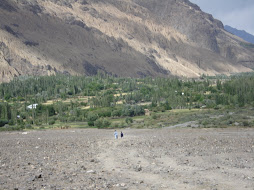An official of the World Bank in Islamabad says the Bank is ready to lend Pakistan $2.25 billion for a trade and energy corridor focusing mostly on Gwadar Port and its land link with China: “the trade and energy corridor that would serve as a gateway for commerce and transport between South Asia, Central Asia, China and the Gulf countries”. In this proposed scheme of things, Pakistan will set up a big oil terminal and refineries at Gwadar with Chinese help because most of the oil will be transported to China from there.
But the World Bank official has made other observations too: “Any land-based trade between the Gulf region and the South Asian states can best take place through Pakistan. The country would work as a link between the Gulf region, Iran, Afghanistan, China and Central Asia and that would make regional states natural trading partners. Pakistan is the ideal approach for the shipment of Indian goods to Afghanistan and the Central Asian markets”. Hopefully we can add the Iran-Pakistan-India (IPI) pipeline to the above project(s) after the complex tripartite negotiations on it are successfully concluded.
But a much more important thing happened during President Asif Ali Zardari’s meeting with the Indian prime minister, Dr Manmohan Singh, in New York. The report says: “The two met on sidelines of the 63rd United Nations General Assembly session and announced a mutual agreement on a number of vital business-related issues. On top of everything else came Pakistan’s agreement to allow Indians an overland access to Afghanistan.”
The trade corridor was first spoken of by General Musharraf in one of his enlightened moments. He was thinking in paradigmatic terms, about converting Pakistan into a trading hub for the regions lying around it. Since he had begun to build the Gwadar Port — not first conceived by him, let us admit — the network of roads and railway tracks branching from the port seemed to leave India out. But later he began to speak in more general terms and was once privately in favour of conceding the Indian request that a corridor be given it for trading with Central Asia.
But the idea of the Indian corridor got stuck because Gen Musharraf deferred to the “defence” angle and abstained from delinking it from Kashmir, despite having established the precedent of delinking the IPI from Kashmir. As a general, he probably realised that he might be standing on the edge of an identity-change of the state of Pakistan. But equally as a general, perhaps he realised the limits of how far he could go in changing the country from a warrior state to a trading nation.
There are two ways of looking at “geopolitical importance”, or two ways of deriving benefit from it. One is the “civilian” approach which means the geographically important state has to develop its roadways and railways, and other infrastructure such as hotels, to facilitate those who wish to pass through. Once the geographically “connective” state has become an effective corridor of passage, its “strategic” importance no doubt increases. And the dividend of this importance comes in economic terms and through an absence of war.
The other way is the “military” approach which relies on geography as “hindrance” rather than “connection”. The military mind says: we are in the middle and we will not let you pass unless you agree to our terms. (To India, we say let’s resolve Kashmir before we talk free trade.) In Pakistan’s case, this approach is often cited also as a raison d’etre for being a military dominated national security state. This is a warrior’s approach and signalises his preference for selective militarism as opposed to generalised economic betterment. In the case of Pakistan, it is the military view of geopolitical importance that has held sway.
Pakistan as a nuclear power is eminently suited to becoming a trade corridor with capacity to lay down the terms compatible with its economic interest. The Central Asian market may be small at this moment and it may be tough for India to compete with China there, but in the coming years the region of SAARC will take what is its due in Central Asia on the basis of shared history and civilisation. Afghanistan has already decided where it wants to stand by joining SAARC. The free trade project of the SAARC “common market” will finally integrate it to South Asia. The Central Asians will follow.
The smuggling that takes place between Pakistan and Afghanistan now supplies markets in Central Asia. The flour Pakistan loses to the region northwest of it will no longer be smuggled because the support price of wheat is now linked to the international price. The next stage is Pakistan organising the Central Asian food supply on the strength of its trade corridor and making the middleman’s money out of it.--Daily Times
Tuesday, October 7, 2008
Subscribe to:
Post Comments (Atom)
Awesome and rugged

Beauty of Chitral

Kishmanja, a beautiful village in Yarkhun valley
Lush green

DIZG: threatened by floods

The legendary village of Ayun in Chitral

On way to Bumburet
Dizg, Yarkhun

Blog Archive
-
▼
2008
(195)
-
▼
October
(50)
- Sit-in staged against delay in Sheshi power house ...
- Govt warned against price hike
- Postgraduate college still a pipe dream in Chitral
- Severe food crisis may hit Chitral
- SELF HELP: Life On The Wrong Side
- Chitral seminar calls for protection of women's ri...
- Education, developmet in Chitral
- Aga Khan's visit still not confirmed
- Chitral: the secrets of my peace!
- Brep: power house project hits snags
- CM okays uplift projects for Chitral
- Work on Yarkhun bridge begins
- NBF readers' club scheme coming to Chitral
- Met official killed in Chitral
- Eliminating women trafficking our collective respo...
- Face of man accused of women trafficking blackened...
- Drosh residents protest power outages
- Rumi’s thoughts can bring stability to world
- Aga Khan's visit to Chitral - Letter 2
- Aga Khan's visit to Chitral -Letter 1
- Lowari tunnel opening to be a gigantic step, says NHA
- Arrangements for Lowari festival reviewed
- Widow's allegations denied
- Proposed Lowari tunnel festival - Letter
- Multi-stakeholder forum - Letter
- Arrangements for Lowari tunnel festival discussed
- Aga Khan to visit Chitral in mid-November?
- Body on women's rights formed in Chitral
- US drones fly over Chitral?
- Five cases of violence against women in Chitral in...
- Bids for trophy hunting invited
- Over 3,000 Benazir income support cards distribute...
- Preparations to welcome Aga Khan in full swing in ...
- Anti-polio drive begins in Chitral
- NHA agrees to open Lowari tunnel in winter
- MNA justifies supporting PPP
- Timely completion of uplift projects ordered
- Impersonator arrested
- Opening of Lowari tunnel for light traffic demanded
- Shortage of technical staff mars uplift in Chitral
- Bajaur blockade to hurt Chitralis too
- Upper Chitral residents to pay bills locally
- Chitral colleges lack hostel facilities
- Over 75,000 children to be administered polio drops
- Trade corridor: paradigm shift we’ve been waiting ...
- Lowari tunnel will be opened this winter
- Woman commits suicide in awi
- Islamabad-Chitral flights still being mismanaged
- JI leader sees conspiracy to establish Ismaili state
- Most Chitralis unable to go home on Eid due to hig...
-
▼
October
(50)
About Me

- Zar Alam Khan Razakhel
- Village Dizg, Yarkhun valley, Chitral, Pakistan
- I blog at http://chitraltoday.net (ChitralToday) about Chitral, its people, culture, traditions and issues. I have been writing about Chitral since 2000. Chitral is a scenic valley in the extreme north-west of Pakistan.
No comments:
Post a Comment